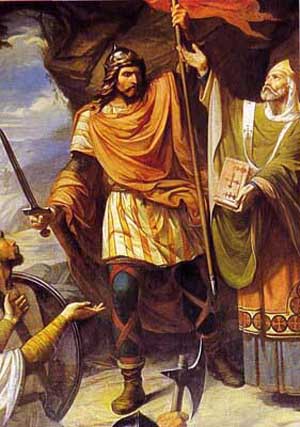 |
Traditionalist Issues
Active versus Passive Resistance
Lyle J. Arnold, Jr.
Basilone Road runs north and south through the Marine Corps base at Camp Pendleton in Southern California. The John Basilone Memorial Highway on Interstate 5 carries traffic past the base. The USS Basilone is a Naval destroyer, and the New Jersey Turnpike Bridge also bears the name. Gunnery Sergeant John Basilone of New Jersey was the son of Italian immigrants and one of ten children. In October of 1942 at Guadalcanal he was ordered to hold back 3,000 Japanese troops attempting to capture Henderson Airfield.
With only 15 men (12 subsequently killed), he held the line for 72 hours. At one point he grabbed a disabled machine gun and dissembled it in complete darkness, found the defect, repaired it by feel, reassembled the weapon, then set it back up and commenced firing. He also crawled through enemy lines to obtain ammunition. At least 38 dead were attributed to him personally, many of them killed at virtually arms length with his Colt .45 pistol.

Sgt. Basilone was part of the Iwo Jima troops |
When he returned to stateside, he was offered a commission but declined, remonstrating to be returned to combat. Basilone was later killed on the beach at Iwo Jima in 1945. He was the only enlisted man in the Marines to be awarded the Congressional Medal of Honor, the Navy Cross, and the Purple Heart (along with several other medals).
Don Pelayo (l) and all his Catholic brother-warriors throughout history would have been proud of Sgt. Basilone. His legacy, like theirs, is a condemnation of passive resistance and a commendation of what a single hero can do against a formidable enemy. In our time this recommends itself to the most important war ever fought, the war with the largest stakes ever in history, the war against Progressivism (2) in the Church.
In his work Action, Catholic writer Jean Ousset rightly affirms:
"There is no more subtle and heinous a perversion than a self-satisfied orthodoxy that is indifferent as to whether truth is fruitful or whether evil is triumphant. A wholly cerebral and speculative orthodoxy is not enough. To be really and vitally orthodox, one needs not only intellectual orthodoxy but, also, what may be termed orthodoxy of the will. And this is manifested principally by a normal readiness for both zeal and indignation" (3).
In other words, an orthodox Catholic must fight an active war, not a passive one. Those who consider themselves soldiers of the Catholic remnant (4) and the Counter-Revolution (5) might ask themselves if their orthodoxy is cerebral and speculative, if they have zeal and indignation against the enemy. One element in the puzzle is whom they are following. Are they following someone who is at the center of the fight? This can only be answered by making an objective and precise definition of who the enemy is, what the enemy is. Without this clear definition, the assessment necessarily becomes subjective.
One camp of Catholics wants to hold the line on liturgical innovations; another wants the return to the Tridentine Mass. One applauds the modern art applied to churches; another is critical of the architectural and artistic deconstructions. One wants seminaries open to homosexuals; another demands a full reform in the seminaries in order to teach good doctrine and customs. One approves co-ed classes and sex education in Catholic schools; another is convinced the only solution for families to form their children is home-schooling.
This short list of variant camps of concerned Catholics is fragmented and woefully incomplete because of the nature of the enemy in the Church. It is, as Prof. Plinio Corrêa de Oliveira affirms, "impalpable and subtle, and as penetrating as a powerful and fearful radiation. All feel its effects, but few know how to name it or to tell us its essence.” He continues:
"This terrible enemy has a name: it is called Revolution ... a process so profound, so vast, and so prolonged ... encompassing every domain of human activity, such as culture, art, laws, customs, and institutions.” (6)

Don Pelayo's coronation as King of Asturias |
His landmark work defines the first four stages of the revolutionary process as Humanism and the Renaissance, the Protestant Revolt, the French Revolution and Communism (7). As the political liberalism of the French Revolution worked its way into the Church by way of liberal philosophy and theology, St. Pius X went to war with his pen in Pascendi. But in half a century his great anti-Modernist offensive was overthrown with Vatican II. Since then, the loud and massive factory of the Council has installed Progressivism with its engineering spectacle, the Novus Ordo, throughout the world.
He who is not in active resistance against Vatican II and the Novus Ordo is fighting something other than Progressivism, the enemy of orthodox Catholicism. By definition he is at the periphery of this war. It has been said that the center of gravity in war is "the hub of all power and movement on which everything depends" (8). From the standpoint of counter-revolutionaries, the hub of Progressivism is Vatican II and the Novus Ordo. Together they form the cruel engine with the desire to destroy (9) the Holy Church.
Corrêa de Oliveira is precise in defining the center of the fight:
"The center, the most sensitive and truly decisive point of the fight between Revolution and Counter-Revolution, has moved from the temporal society to the spiritual society. It has come to be the Holy Church" (10).
In physics, inertia is the tendency of matter to remain at rest if at rest or, if moving, to keep moving in the same direction unless affected by some outside force. For two score years since Vatican II, this inertia has built up speed because so many have taken the position of passive resistance.
Knowing that passive resistance would bring defeat, Sgt. Basilone and Don Pelayo placed themselves in danger’s way to be the active outside force opposing the enemy. Militancy demands that Catholics likewise place themselves at the center of the fight against the Progressivist enemies of the Church.
Venerable Mary of Agreda wrote, "The stone falls the more swiftly the closer it approaches to its center of gravity ... It is true in the spiritual order what philosophers claim in the corporal: that the nearer a moving object approaches its center of attraction, the more powerfully it is drawn to that center." (11).
The stone of Progressivism falls more swiftly each day to its center, its aim to destroy the Church and what is left of Christian Civilization. Those who fight and labor in continual active resistance "are few." (Matt. 9: 37) May Our Lady of Good Success act in the spiritual order, drawing to Herself more soldiers for the Counter Revolution, so that the Progressivist center of gravity will be attacked with holy zeal for the Catholic cause.
1. Marian Therese Horvat, Ph.D. The Legend of Don Pelayo, Available from Tradition in Action.
2 Atila Sinke Guimaraes, "Liberals, Modernists and Progressivists," Tradition in Action website, "Hot Topics: Traditional Issues"
3. Jean Ousset, quoted from Catholic Family News, May 2003, page 3.
4. A. S. Guimaraes, The Fidelity of the Remnant through History Tradition in Action website, ""
5. A. S. Guimaraes, "Conservatives, Traditionalists and Counter-Revolutionaries," Tradition in Action website, “Hot Topics: Traditional Issues,"
6. Plinio Correa de Oliveira, Revolution and Counter-Revolution, New Rochelle, NY: The Foundation for a Christian Civilization,, 1980, p. 18.
7. Ibid.
8. Carl von Clausewitz, On War, Everyman's Library, Alfred A. Knoph, NY, 1993, Book 8, Chapter 4, p. 720.
9. Animus Delendi I(Desire to Destroy), and Animus Delendi II are volumes 4 and 5 in the collection Eli. Eli, Lamma Sabacthani? by A. S. Guimaraes, available through Tradition in Action.
10. P. Correa de Oliveira, Revolution and Counter-Revolution, pp. 152, 153.
11. Mary of Agreda, City of God, Vol. 4, "The Coronation," pp. 510, 511.

Posted August 22, 2008

Related Topics of Interest
 Our Lady of Covadonga and Don Pelayo Our Lady of Covadonga and Don Pelayo
 Heading to a Hybrid Mass Heading to a Hybrid Mass
 The Fidelity of the Remnant through History The Fidelity of the Remnant through History
 Conservatives, Traditionalists and Counter-Revolutionaries Conservatives, Traditionalists and Counter-Revolutionaries
 The Spanish Shame The Spanish Shame
 Liberals, Modernists and Progressivists Liberals, Modernists and Progressivists
 Revolution and Counter-Revolution - Overview Revolution and Counter-Revolution - Overview

|

Traditionalism | Hot Topics | Home | Books | CDs | Search | Contact Us | Donate

© 2002- Tradition in Action, Inc. All Rights
Reserved
|
 |
|
